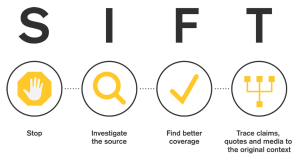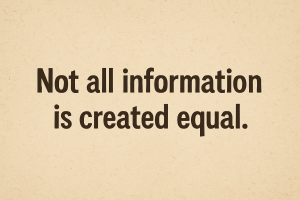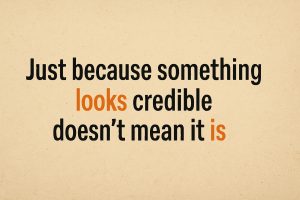Media Literacy
Kainan Jarrette and Diana Daly
What is Media Literacy?
Self-evaluation!
Before reading on, fill out and export the following survey:
Media literacy is the ability to access, understand, analyze, evaluate, and create media in a critical and informed way. By media we’re referring to any channel or method of communication. This includes (but isn’t limited to):

- Books
- Magazines
- Newspapers
- Radio/podcasts
- Television
- Movies
- Videos
- Websites
- Social media
As you can see, you encounter media all the time in your everyday life. And whether it’s fictional or non-fictional content, it’s all helping to shape your view of the world. Therefore, being able to apply critical thinking when engaging with this content is vital.
This book will be focusing primarily on non-fictional content, but it’s still important to know that media literacy also applies to fictional content. In practice, good media literacy can look like:
| Non-Fiction Content | Fictional Content |
| Discerning if a particular website is a credible source of information | Recognizing when something is parody or satire (such as The Onion) |
| Being able to fact-check claims made in a Facebook post | Recognizing intentional irony |
| Reading an entire news article before sharing, as opposed to just the headline | Recognizing that fiction can still contain bias and ideological framing |
| Recognizing the difference between opinion and journalistic reporting | Recognizing that fictional portrayals of history and real events aren’t neutral or reliably accurate |
| Understanding how algorithms shape what you see and are suggested | Understanding allegory, metaphor, and subtext |
| Navigating user reviews of products online | Recognizing how tropes can be harmful in the real world |
| Recognizing emotionally manipulative language in content | Recognizing that fictional behavior is not a substitute for ethical norms |
The “SIFT” Method

Developed by Mike Caulfield, the SIFT method1 is a simple and straightforward way to investigate the credibility of information, particularly for online sources. The steps are:
Stop
 Before reading or sharing content, STOP!
Before reading or sharing content, STOP!
With everything going on in a typical day, it’s very easy to be in a state where you’re passively engaging with media. But passive engagement means we’re likely not scrutinizing the content or ourselves to the level we should be when this type of information is presented.
Taking a moment to stop lets you switch to an active engagement, where you can more specifically exercise your media literacy skills, such as:
- Evaluating the emotional content of an article
- Assessing your own emotional state as you’re reading
- Thinking about what you already know on the topic
Investigate the Source
 Take a moment to look up the author, website, etc of the content you’re engaging with. In particular, look for things like:
Take a moment to look up the author, website, etc of the content you’re engaging with. In particular, look for things like:
- Does the source likely have an ideological bias or goal in mind?
- Does the source have any authority on the topic being discussed?
Find Better Coverage
 It’s important to see what other sources are saying about the same claim or topic. Try to find other credible sources that either:
It’s important to see what other sources are saying about the same claim or topic. Try to find other credible sources that either:
- Corroborate the information or claim
- Dispute the information or claim
Additionally, it’s often a good idea to see if credible, non-partisan fact-checking sites have already covered the article or content. These can include:
Trace Claims, Quotes, and Media to Their Original Source
 Articles will frequently make claims based on other second-hand information, such as:
Articles will frequently make claims based on other second-hand information, such as:
- Academic studies
- Quotes from other people, groups, and articles
- Visuals such as graphs, photos, or videos
However, it’s not uncommon for articles to misrepresent these things. This could mean:
- Improperly summarizing the findings of a study
- Taking a quote out of context
- Using visuals out of context
It’s important to try to find the primary source of content like the above, and ask yourself questions like:
- Do the conclusions drawn by the author(s) of a study match the claims that were made in the article referencing the study?
- Did a referenced quote come from the person the article claimed it did? Was the way the article used that quote fair to the context the quote came from?
- Are the visuals that are used actually directly related to the content discussed in the article? Did the article edit anything out of the original piece of media that was important?
Red Flags and Fake Green Flags
Red Flags
In addition to the “SIFT” method, there are also some consistent red flags you should be on the lookout for in both the headlines and body of articles, posts, media, etc.
 No Author or Organization Listed
No Author or Organization Listed
If you can’t tell who created the content or what organization is behind it, it’s hard to hold it accountable or verify its credibility.
 Emotionally Charged or Sensational Language
Emotionally Charged or Sensational Language
Terms and phrases like “under attack,” “BETRAYAL,” “You’ll never guess…”, “EXPOSED” and so on are examples of language specifically designed to trigger your emotions. As a general rule, if you find the language being used is giving you an immediate emotional response, you should be on guard.
 No Sources or Unsupported Claims
No Sources or Unsupported Claims
Reliable media backs up its claims with sources, and ideally ones that are cited, linked, or verifiable. An article that makes no attempt to back up its claims with specific and direct sources is a major red flag.
 Poor Grammar, Spelling, or Formatting
Poor Grammar, Spelling, or Formatting
Frequent errors or sloppiness can indicate a lack of editorial standards or rushed, low-effort content generation. This doesn’t mean an article with these errors is definitely inaccurate, but it’s a red flag that should make you examine the content much more closely.
 One-Sided or Highly Biased Presentation
One-Sided or Highly Biased Presentation
Particularly if the content is about something you know to be controversial, a one-sided presentation is a major red flag. Most media outlets have some degree of a political leaning, but reputable outlets will still cover both sides of an issue, because they want you to have the full context.
Fake Green Flags
In addition to red flags, it’s also important to recognize what we’ll call fake green flags. These are things that mimic credibility, but without doing the other steps to support it. It’s easy to mistake them for signs of trustworthiness, which can leave you vulnerable to misinformation.
 The speaker sounds confident and articulate.
The speaker sounds confident and articulate.
Confidence can be very appealing, but it doesn’t equal accuracy. Skilled speakers (and influencers) can make false or misleading claims sound persuasive, even when they’re wrong.
 A lot of technical or academic-sounding language and visuals are used.
A lot of technical or academic-sounding language and visuals are used.
Jargon can impress, but also obscure. Complex language can be used to overwhelm or distract rather than clarify. The same is true of “science-y” visuals, such as graphs and charts. These things aren’t inherently bad, but they’re also not a reliable sign of accuracy.
 Buzzwords like “balanced,” “independent,” or “free thinker” are used.
Buzzwords like “balanced,” “independent,” or “free thinker” are used.
These words and phrases can be used as rhetorical shields against actual critical thinking. Typically speaking, a credible author won’t have to rely on buzzwords to convince you that they’re fair and balanced — they’ll just present the information in a fair and balanced way.
 The content is posted in a “documentary” or “news-style” format.
The content is posted in a “documentary” or “news-style” format.
Styling something like journalism doesn’t make it journalism. Many propaganda videos mimic traditional news to gain trust. Again, this style doesn’t guarantee a source is untrustworthy, but it also doesn’t guarantee that it’s accurate either.
 The post or video has gone viral.
The post or video has gone viral.
Popularity is not proof. Viral content spreads because it’s emotional, surprising, or relatable—not because it’s true.
TL;DR



Chapter Quiz and Short Essay
Knowledge Check: Media Literacy
Short Essay: Media Literacy
Vocabulary
media
any channel or method of communication
media literacy
the ability to access, understand, analyze, evaluate, and create media in a critical and informed way
References
1 Caulfield, M. (2019, June 19). SIFT (The four moves). Hapgood. https://hapgood.us/2019/06/19/sift-the-four-moves/
Media Attributions
- Types of Media © ChatGPT is licensed under a CC0 (Creative Commons Zero) license
- SIFT Infographic © Mike Caulfield is licensed under a CC BY (Attribution) license
- STOP © ChatGPT is licensed under a CC0 (Creative Commons Zero) license
- Investigate © ChatGPT is licensed under a CC0 (Creative Commons Zero) license
- Better Coverage © ChatGPT is licensed under a CC0 (Creative Commons Zero) license
- Tracing © ChatGPT is licensed under a CC0 (Creative Commons Zero) license
- Red Flag © ChatGPT is licensed under a CC0 (Creative Commons Zero) license
- Fake Green Flag © ChatGPT is licensed under a CC0 (Creative Commons Zero) license
- Media Literacy Text 01 © ChatGPT is licensed under a CC0 (Creative Commons Zero) license
- Media Literacy Text 02 © ChatGPT is licensed under a CC0 (Creative Commons Zero) license
- Media Literacy Text 03 © ChatGPT is licensed under a CC0 (Creative Commons Zero) license
the ability to access, understand, analyze, evaluate, and create media in a critical and informed way
any channel or method of communication
the practice of carefully analyzing information, beliefs, and arguments in order to make well-reasoned decisions, form justified beliefs, and avoid being misled

